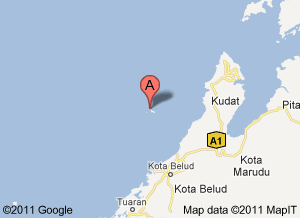The corals surrounding Mantanani Island of Sabah, East Malaysia seem to be in a pretty bad shape. Diving there last week at three different dive sites, I observed the following: that nearly half the coral reefs had been bombed out and reduced to rubbles, about 80% of the corals are covered with algae of which 50% are already dead.
 First the bombing. This is due to destructive fishing method used by fishermen (Philippines is blamed but let's not rule out locals too) who have no clue about the long-term damage caused to marine habitats when seeking immediate gratification. It started about 30 years ago, according to local sources, and still continues presently from time to time. Lack of monitoring resources by marine police allows this violation against ocean ecosystems to continue.
First the bombing. This is due to destructive fishing method used by fishermen (Philippines is blamed but let's not rule out locals too) who have no clue about the long-term damage caused to marine habitats when seeking immediate gratification. It started about 30 years ago, according to local sources, and still continues presently from time to time. Lack of monitoring resources by marine police allows this violation against ocean ecosystems to continue.
As for algal bloom, there are sites where green algae seems to be the only colour visible from a distance and up close. Upon closer inspection, a lot of the corals are covered with an inch thick algae, smothered to death as algae deprives the very oxygen needed by the coral to survive. Reddish brown algae has also been noted at Mantanani Kechil dive site. And a few jellyfish too.
As I had only the chance to dive at three sites (Roxy Point and Police Gate at Mantanani Besar, and one at Mantanani Kechil), I cannot say what it is like on the other 10 dive sites or more. However the dive guides tell me that the corals aren't any better elsewhere. The dive sites I had dived for the purpose of a review for Gaia Discovery apparently are the best the island can offer! Fish population is very small, there is no abundance of reef fish or pelagic fish; however I did see a baby hawksbill turtle, a lone barracuda, lobsters and two huge octopi holding hands!
The waters had warmed significantly over the last year, as high as 5-6 degrees above the usual 25-26 degrees celsius, according to Kristen Soong, a marine biologist at the Marine Ecology Research Center at Gayana Eco Resort. The rise in water temperature coupled with (I suspect) increased nutrient content in the seawater as a result of untreated sewage from the villages may be factors causing the algal bloom. There are around 200 people living on the island on two separate villages, and about five chalet type of accommodation.
Dive guides and boat crew alike seem to smoke and drop cigarette butts into the very sea that gives them food and pocket money. And my dive guide handled the sea creatures by hand and shoved them around with a metal stick for us to have a better view! Yes, I had to tell him not to do that repeatedly once on the surface, and he didn't seem convinced with my explanation of leaving the creatures alone else they will be stressed. A couple of snorkellers were even given a live starfish as a souvenir. What a cowboy outfit!
When I highlighted the algal bloom phenomenon, the dive guides and instructors of Scooba Tank Dive Center were surprised to hear that this was a bad thing. They admitted having a lack knowledge of corals and coral health, and requested that I write in to the authorities about this, for external help.
The poor coral health due to algal bloom is a serious problem that has to be investigated and attended to by the environment ministry, agencies and marine scientists. In my humble opinion, lack of attention and mitigation efforts will mean that Mantanani Island's corals will eventually be a limestone graveyard for all to weep over. I sincerely hope I will be wrong. -Mallika Naguran
Getting to Mantanani Isand: Take a car/van from Kota Kinabalu on a two and half hour drive to Kota Belud, then connect to a fast boat from Ostrich Farm Resort jetty or Rampayan Laut jetty. Boat takes 45mins to reach Mantanani Besar. Day or overnight stays with snorkelling/diving can be booked with most travel agents such as Discovery Tours.